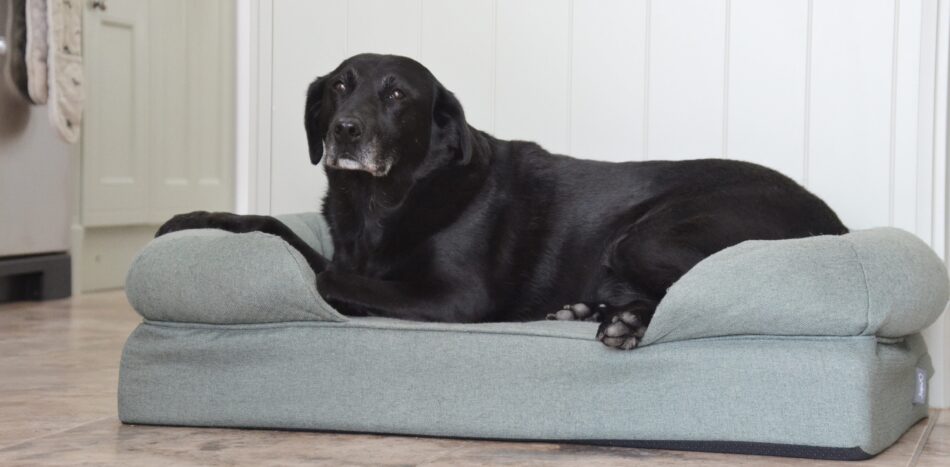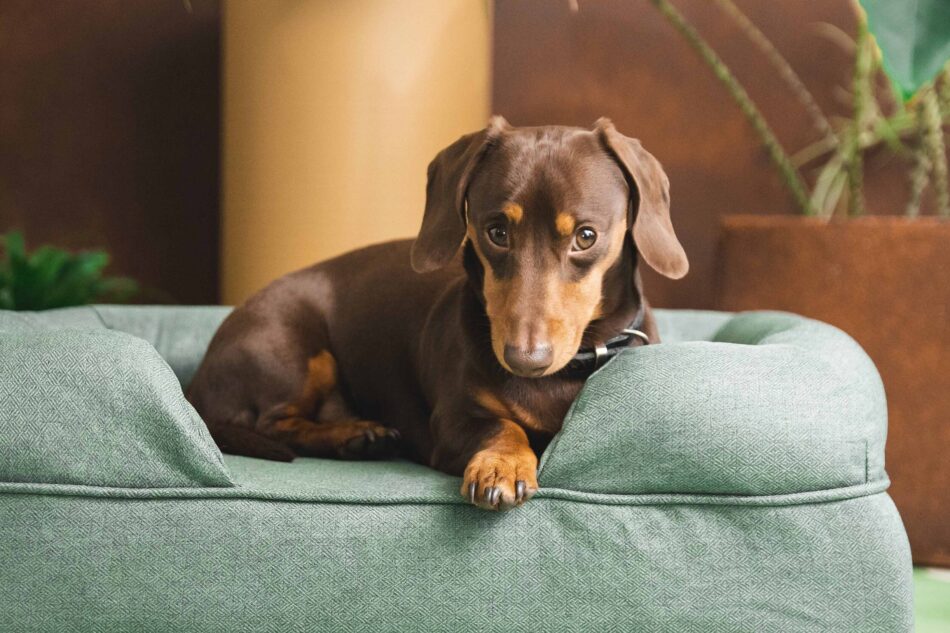Choose the Right Bed for Your Dog
Dogtor™ Adem, Dog behaviourist & trainer, discusses everything you need to know about dog beds, which types may suit which breed and age of dog, and why we might see our four-legged best friends exhibit certain behaviours in and around their beds. Read on to learn more!
What should I look for in a dog bed?
A dog bed should be comfortable for the breed type, age and size of your dog. If you have an older dog, they might benefit from an orthopedic or memory foam bed, such as the Omlet Bolster Bed with premium memory foam mattress, which gives support by gently moulding around your dog. A puppy, on the other hand, might benefit from a bed that can absorb water if, for example, a bowl of water is accidentally knocked over by them or they ‘toilet’ on their bed area whilst still being house trained. For puppies, you may also want to consider a type of bedding that is comfortable for them but not too precious or expensive due to the higher risk of this bedding being chewed or damaged as they play and explore. For me, it is also important to choose a bed that is robust and can be easily washed. Again the Omlet Bolster bed is a great choice with this feature! This not only helps the environment by limiting the need to frequently replace a smelly or very worn dog bed with a new version, but also ensures any accidents or dirt brought into their dog bed area can be easily cleaned away, keeping their bed area hygienic and inviting. You could also consider covering your dog’s bed with a removable and washable cover, particularly in the winter months.
What type of bed might suit my breed of dog?
Certain breeds might need more cushioning than others to stay comfortable and limit their potential for developing sores or sore patches, for example greyhounds who are considered more ‘boney’ than many other breeds. Some breeds might also like to curl up, for example a husky or some of the smaller breeds, whilst others prefer to lay on their side and stretch out, for example hounds such as deer hounds, greyhounds, and lurchers. An owner should consider how their individual dog likes to lay and relax and choose a suitable bed with this in mind.
The time of year can also have an effect on where your dog chooses to sleep. To ensure your dog remains comfortable, you can adapt their bed to suit the season by adding extra blankets or even cool mats to your dog’s bed. If you’re looking for a cozy blanket, Omlet’s Super Soft Dog Blanket is definitely a winner for those cooler months where some dogs might like to ‘snuggle up’. For the warmer months of the year, you could try a cool mat instead of their usual bed if it is particularly hot! Omlet’s Cooling Mat for Dogs is a perfect choice, coming in a range of sizes to suit many breeds.
I have observed my dog ‘digging’ their bed, why is this?
This is a natural instinct derived from the need to ‘clear the ground’ or an area of insects and potentially small rodents and reptiles. Ancestors of our pet dogs might need to do this in order to make the area they are choosing to reside in safe for them to lay down in. Some dogs, such as those in tropical climates that predominantly live outside or live as ‘street dogs’, still use this instinctive behaviour to keep themselves from being bitten and stung. This act of ‘clearing the ground’ may even have benefits in preventing parasite infestation. Whilst in Mauritius last year, I witnessed a young street dog clearing an area and whilst watching I noticed that she stopped in her tracks and became very observant as she had disturbed a small scorpion in some leaves. Without this act of digging and clearing, this dog would have undoubtedly been stung by this scorpion.
Dogs may also dig because they sweat through their paws, making the act of digging and ‘circling’ in an area another way of spreading and leaving their scent. This is something we commonly know as ‘marking’ and usually associate with the image of dogs urinating up lamp posts!
Finally, dogs may also dig naturally on hot days and in hot climates in an attempt to try to remove hot surfaces (e.g. baked earth). This helps them to reveal a cooler surface to reside in. In addition, wild canids such as arctic foxes and wolves, may dig to avoid extreme weather such as high wind, the cold (e.g. snow), and storms. Again, this act helps to keep them safe as well as assists in regulating their body temperature. Although seldom needed in the pet dog world today, this instinctive behaviour still remains in part in our domesticated dogs.
How can I train my dog to sleep in their bed?
A good training instructor or behaviourist will have this on their training syllabus, helping owners to teach the ‘go to bed’ command.
If, however, your dog is reluctant to sleep in their own bed you should investigate why. Firstly consider, is the bed area provided the most attractive sleeping area available to your dog? Positive reinforcement such as offering treats in this area can help to make their bed area a more positive and inviting place to reside, as can ensuring the bed is comfortable for their breed type and age (as discussed above!) Secondly, you might want to evaluate if your dog potentially has a behavioural issue such as separation anxiety that is preventing them from wanting to sleep in their own bed. If you believe this to be the case, you should seek help from a certified behaviourist to address this issue and help to build your dog’s confidence in being physically away from you.
How can I stop my dog destroying their bed?
Think about your dog’s life stage. A young puppy may chew a bed as they explore with their mouth and enjoy the texture on their teething gums. In this instance, it would be advisable to buy a bed that does not contain lots of small parts or stuffing that can be ingested. Similarly, you could pick bedding made of material that can not easily be broken down through the act of chewing. You can always buy a ‘nicer’ bed for your dog to use under your direct supervision until they have passed this life stage and have lost their baby teeth and gained all of their adult teeth.
If your dog is older and destroying their bed, perhaps when they are left alone for example, this could potentially signal that your dog is feeling stressed and is suffering from separation anxiety, for which behavioural advice should be sought to enable your dog to recover from this issue.
Similarly, chewing and destroying of beds can also sometimes indicate that your dog is bored. To combat this, you could look to try to tire your dog more effectively before leaving them alone, which will encourage them to rest more in your absence. You should also ensure that your dog is not left for long periods of time by themselves. Just like us, dogs are social mammals and need company. As well as ensuring your dog is appropriately exercised and is not being left for too long, you can also offer your dog something to do for some of the time you are away from them. For example, you could leave them something else to chew that is safe and made for this purpose. Consider leaving them with a hard chew food item or a food dispensing toy filled with tasty treats for them to try to get to!
I hope you have found the above information useful. Wishing your beautiful pooches the most restful of snoozes!
Dogtor™ Adem
Dog Behaviourist & Trainer
www.dog-ease.co.uk
@dogtoradem
This entry was posted in Dogs

